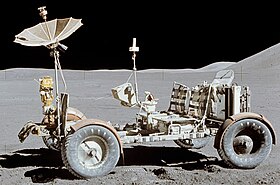Lunar Roving Vehicle
| Lunar Roving Vehicle | |
|---|---|

|
|
| Overview | |
| Manufacturer | |
| Also called |
|
| Designer | |
| Powertrain | |
| Electric motor | Four 0.25-horsepower series-wound DC motors |
| Hybrid drivetrain | Four 80:1 harmonic drives |
| Battery | Two silver-oxide, 121 A•h |
| Range | Greater than 35.9 km (22.3 mi) |
| Dimensions | |
| Wheelbase | 2.3 m (90.6 in) |
| Length | 3.1 m (122.0 in) |
| Height | 1.14 m (44.9 in) |
| Curb weight |
|
The Lunar Roving Vehicle (LRV) or lunar rover is a battery-powered four-wheeled rover used on the Moon in the last three missions of the American Apollo program (15, 16, and 17) during 1971 and 1972. It was popularly known as "moon buggy", a play on the words "dune buggy".
The LRV was transported to the Moon on the Apollo Lunar Module (LM) and, once unpacked on the surface, could carry one or two astronauts, their equipment, and lunar samples. The three LRVs remain on the Moon.
The concept of a lunar rover predated Apollo, with a 1952–1954 series in Collier's Weekly magazine by Wernher von Braun and others, "Man Will Conquer Space Soon!" In this, von Braun described a six-week stay on the Moon, featuring 10-ton tractor trailers for moving supplies.
In 1956, Mieczyslaw G. Bekker published two books on land locomotion. At the time, Bekker was a University of Michigan professor and a consultant to the U.S. Army Tank-Automotive Command's Land Locomotion Laboratory. The books provided much of the theoretical base for future lunar vehicle development.
In the February 1964 issue of Popular Science, von Braun, then director of NASA's Marshall Space Flight Center (MSFC), discussed the need for a lunar surface vehicle, and revealed that studies had been underway at MSFC in conjunction with Lockheed, Bendix, Boeing, General Motors, Brown Engineering, Grumman, and Bell Aerospace.
...
Wikipedia
